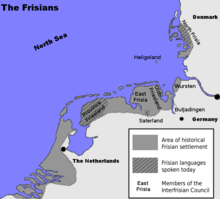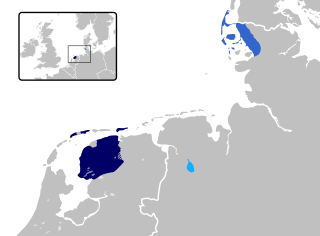
The Frisian languages are a closely related group of West Germanic languages, spoken by about 400,000 Frisian people, who live on the southern fringes of the North Sea in the Netherlands and Germany. The Frisian languages are the closest living language group to the Anglic languages; the two groups make up the Anglo-Frisian languages group and together with the Low German dialects these form the North Sea Germanic languages. However, modern English and Frisian are not mutually intelligible, nor are Frisian languages intelligible among themselves, owing to independent linguistic innovations and language contact with neighboring languages.
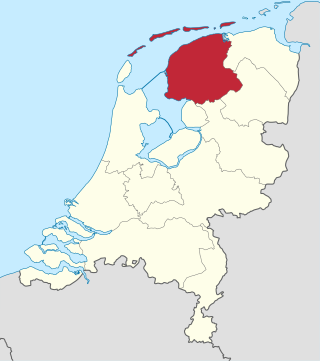
Friesland, historically and traditionally known as Frisia, named after the Frisians, is a province of the Netherlands located in the country's northern part. It is situated west of Groningen, northwest of Drenthe and Overijssel, north of Flevoland, northeast of North Holland, and south of the Wadden Sea. As of January 2023, the province had a population of about 660,000, and a total area of 5,753 km2 (2,221 sq mi).
Frisian(s) most often refers to:

Frisia is a cross-border cultural region in Northwestern Europe. Stretching along the Wadden Sea, it encompasses the north of the Netherlands and parts of northwestern Germany. Wider definitions of "Frisia" may include the island of Rem and the other Danish Wadden Sea Islands. The region is traditionally inhabited by the Frisians, a West Germanic ethnic group.
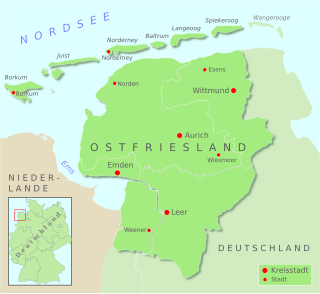
East Frisia or East Friesland is a historic region in modern Lower Saxony, Germany. The modern province is primarily located on the western half of the East Frisian peninsula, to the east of West Frisia and to the west of Landkreis Friesland but is known to have extended much further inland before modern representations of the territory. Administratively, East Frisia consists of the districts Aurich, Leer and Wittmund and the city of Emden. It has a population of approximately 469,000 people and an area of 3,142 square kilometres (1,213 sq mi).
Old Frisian was a West Germanic language spoken between the 8th and 16th centuries along the North Sea coast, roughly between the mouths of the Rhine and Weser rivers. The Frisian settlers on the coast of South Jutland also spoke Old Frisian, but there are no known medieval texts from this area. The language of the earlier inhabitants of the region between the Zuiderzee and Ems River is attested in only a few personal names and place-names. Old Frisian evolved into Middle Frisian, spoken from the 16th to the 19th century.

West Frisian, or simply Frisian, is a West Germanic language spoken mostly in the province of Friesland in the north of the Netherlands, mostly by those of Frisian ancestry. It is the most widely spoken of the Frisian languages.

Saterland Frisian, also known as Sater Frisian, Saterfrisian or Saterlandic, spoken in the Saterland municipality of Lower Saxony in Germany, is the last living dialect of the East Frisian language. It is closely related to the other Frisian languages: North Frisian, spoken in Germany as well, and West Frisian, spoken in the Dutch province of Friesland.

North Frisian is a minority language of Germany, spoken by about 10,000 people in North Frisia. The language is part of the larger group of the West Germanic Frisian languages. The language comprises 10 dialects which are themselves divided into an insular and a mainland group.

The Anglo-Frisian languages are the Anglic and Frisian varieties of the West Germanic languages.

The Frisii were an ancient tribe, living in the low-lying region between the Rhine–Meuse–Scheldt delta and the River Ems, sharing some cultural and linguistic elements with the neighbouring Celts. The newly formed marshlands were largely uninhabitated until the 6th or 5th centuries BC, when inland settlers started to colonize the area. As sea levels rose and flooding risks increased, the inhabitants learned to build their houses on village mounds or terps. The way of life and material culture of the Frisii hardly distinguished itself from the customs of the Chaucian tribes living farther east. The latter, however, were considered to be part of the Germanic tribal confederation.
The Frisiavones were a Germanic people living near the northern border of Gallia Belgica during the early first millennium AD. Little is known about them, but they appear to have resided in the area of what is today the southern Netherlands, possibly in two distinct regions, one in the islands of the river deltas of Holland, and one to the southeast of it.
Dutch dialects and varieties are primarily the dialects and varieties that are both cognate with the Dutch language and spoken in the same language area as the Standard Dutch. They are remarkably diverse and are found within Europe mainly in the Netherlands and northern Belgium.
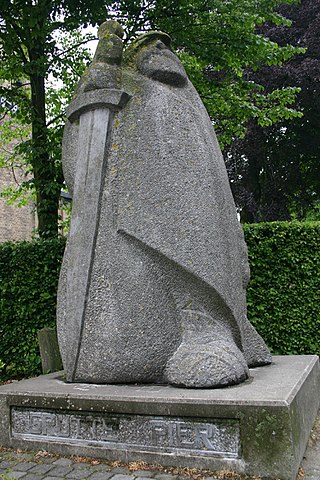
Frisia is a small region in the north of the modern day country known as the Netherlands. In the Iron Age, the ancestors of the modern Frisians first migrated south out of modern day Scandinavia to the south west where they began to settle along the coast. The archeological record goes all the way back to the Neolithic era, however, the first written sources for Frisian history come from Roman records, like Tacitus' account of an unsuccessful Frisian attack on a Roman fort. Frisia would go on to distinguish itself culturally from other Germanic peoples but remained recognizably Germanic nonetheless. In the Early Medieval era, Frisians took the seas with well crafted ships to perform trade and to raid other ports, cities, and towns in other parts of Europe. For most of its modern history, Frisia, or Frysland, has been under the control of the Netherlands but today their language is co-official with Dutch at the provincial level. Frisian is the most closely related language to English aside from Scots.

The Frisian Kingdom is a modern name for the post-Roman Frisian realm in Western Europe in the period when it was at its largest (650–734). This dominion was ruled by kings and emerged in the mid-7th century and probably ended with the Battle of the Boarn in 734 when the Frisians were defeated by the Frankish Empire. It lay mainly in what is now the Netherlands and – according to some 19th century authors – extended from the Zwin near Bruges in Belgium to the Weser in Germany. The center of power was the city of Utrecht.

East Frisians are, in the wider sense, the inhabitants of East Frisia in the northwest of the German state of Lower Saxony. In the narrower sense the East Frisians are the eastern branch of the Frisians, a distinct Germanic ethnic group, and are one of the nationally recognized ethnic minorities in Germany, along with the Danes, Sorbs, Sinti and Romanies. They are closely related to the Saterland Frisians, who come from East Frisia and moved from the coastal region to the interior. The East Frisians are also related to the North Frisians and the Westlauwers Frisians.

Frisian nationalism refers to the nationalism which views Frisians as a nation with a shared culture. Frisian nationalism seeks to achieve greater levels of autonomy for Frisian people, and also supports the cultural unity of all Frisians regardless of modern-day territorial borders. The Frisians derive their name from the Frisii, an ancient Germanic tribe which inhabited the northern coastal areas in what today is the northern Netherlands, although historical research has indicated a lack of direct ethnic continuity between the ancient Frisii and later medieval 'Frisians' from whom modern Frisians descend. In the Middle Ages, these Frisians formed the Kingdom of Frisia and later the Frisian freedom confederation, before being subsumed by stronger foreign powers up to this day.
The Anglo-Saxon settlement in the Netherlands was a movement of continental Angles, Saxons, Franks and possibly English Anglo-Saxons into the lands formerly inhabited by the ancient Frisii, Cananefates and Batavians. These migrations occurred after the population drop of the Frisii during the 5th century up until the 7th century. These new migrants from northwestern Germany were later referred to as the Frisians by the Merovingian Franks who may have taken this name from older Roman historiography. During these migrations, almost the entire population of the coastal Netherlands was demographically replaced.
The Netherlands in the early Middle Ages was inhabited by various Germanic tribes, including the Frisians, who played a significant role in the development of the region and its Christianisation and eventual incorporation into the Frankish Empire.

